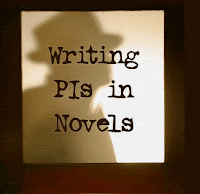****Update: The winners, picked at random from the individuals leaving comments on PIs, Car Chases, and Squealing Brakes. are: Chester Campbell and Chelle. Each is eligible for either a “Writing PIs” T-shirt or one free class from www.writingprivateinvestigators.com Please e-mail The Stiletto Gang using the “Contact Us” link on the right side of this blogsite so we can tell you how to claim your prize. Thanks.
The Stiletto Gang
_____________
 I noticed your guest blogger last week was Lisa Lutz, who has a very funny car chase prologue that kicks off her wonderfully entertaining book The Spellman Files (the first in her Spellman series). I laughed when I first read the prologue, laughed again when I read it to my husband (who’s also my business partner in our private investigator [PI] agency), then laughed all over again when I read it to his teenage daughter (who, with a PI dad and a PI stepmom, is similar to the protagonist in The Spellman Files). Suffice it to say, we’re a real-life PI family who are fans of the fictional PI family, the Spellmans.
I noticed your guest blogger last week was Lisa Lutz, who has a very funny car chase prologue that kicks off her wonderfully entertaining book The Spellman Files (the first in her Spellman series). I laughed when I first read the prologue, laughed again when I read it to my husband (who’s also my business partner in our private investigator [PI] agency), then laughed all over again when I read it to his teenage daughter (who, with a PI dad and a PI stepmom, is similar to the protagonist in The Spellman Files). Suffice it to say, we’re a real-life PI family who are fans of the fictional PI family, the Spellmans.
But what about such car chases in real life? I mean, besides the Spellmans, think about all those groovy car chases and squealing, burning brakes in every one of those old Rockford episodes (for those uninitiated to this classic PI series, do yourself a favor and check out The Rockford Files, a ‘70s TV series starring an ex-convict turned laid-back PI, played by James Garner, who also did his own car stunts in the show).
 Fortunately, those exciting, nail-biting car chases only take place in fiction. In the real-world, PIs drive more safely and have guidelines for mobile, also called rolling, surveillances (meaning, surveillances conducted while driving a car or van). I thought I’d discuss some mobile surveillance techniques for fans of The Stiletto Gang blog as some of you are also writers and might find them useful for your stories.
Fortunately, those exciting, nail-biting car chases only take place in fiction. In the real-world, PIs drive more safely and have guidelines for mobile, also called rolling, surveillances (meaning, surveillances conducted while driving a car or van). I thought I’d discuss some mobile surveillance techniques for fans of The Stiletto Gang blog as some of you are also writers and might find them useful for your stories.
First of all, let’s debunk the myth that mobile surveillances are one-man (or one-woman) shows.
One-Person Mobile Surveillance: Recipe for Failure?
There are investigators who swear that a one-person mobile surveillance is a recipe for failure (one PI gives a 5% success rate). In our agency, we can vouch that a one-person mobile surveillance is tough. You’re watching traffic and pedestrians and intersections and traffic lights and regulatory traffic signs and your subject is weaving and gunning it through rush-hour traffic and…
You just lost him.
We now counsel prospective clients that a two-person surveillance significantly increases the chances of success. Our preference is two investigators in two vehicles, but even two investigators in one vehicle improves the success rate of a mobile surveillance (one investigator can focus on driving while the other takes video/photographs, checks directions, stays focused on where the subject’s car is turning, etc.)
Nevertheless, at our agency there are times where one of us ends up doing a solo mobile surveillance. Sometimes by accident. For example, both of us were surveiling a felon a while back. We were in two cars, communicating with each other by walkie talkies. We’d researched the area, knew all the streets, and we prepared to do a two-person mobile surveillance. When the target turned on a side street, I followed, but my husband got caught in a rush-hour traffic jam. Miraculously, I did a one-person mobile surveillance through three counties, all the while tracking the felon, and ultimately tagging the location he ended at (which had been our goal). But I’ll tell you, both of us still shake our heads over that one—we still can’t believe we pulled off a one-car/one-investigator mobile surveillance through three counties. For those of you writing a sleuth story, maybe he/she knows the stakes are against him/her in a lengthy one-person mobile surveillance, but goes for it anyway.
 Tips for Conducting a One-Vehicle, One-Investigator Mobile Surveillance
Tips for Conducting a One-Vehicle, One-Investigator Mobile Surveillance
If your fictional sleuth is stuck, such as I was, in a one-vehicle, one-investigator mobile surveillance, think about using some of the following techniques:
- Have him/her stay in the right lane most of the time. If that’s not possible, use the center lane (that way, your PI can respond to either a right turn or left turn at the last moment).
- If it’s a night surveillance, have your sleuth disable the dome light. Some real-life PIs put black tape over any miscellaneous interior lights as well (digital clocks, radio dials, etc.).
- While following, have your sleuth try to keep one car between his/her vehicle and the vehicle being following.
- Rather than stop directly behind the subject at a red light, see if there is a parking lot your sleuth can pull into until the light changes.
- If your fictional PI has an associate riding shotgun, besides taking photos, reading maps, etc., that person can also jump out for foot surveillance if necessary.
Tips for Conducting a Two vehicle/Two investigator Mobile Surveillance
Much better odds with two cars, two PIs. Below are some tips for this scenario:
- If your fictional PI has a good idea where the subject is going, he/she might travel in front of the target’s vehicle (be the lead) while the second PI travels behind the target’s vehicle.Using radios, the lead unit stays fairly close to the subject (no more than three or four cars in front). If the trailing unit sees the subject signal for a turn, he can radio the lead unit in time for it to make the same turn ahead of the subject.
- Play leapfrog: If the trailing unit gets cut off by a missed light or some other obstacle, he/she can radio the lead unit to drop back and behind the subject. The cut-off unit can then, by following the instructions radioed by the still in-contact unit, cut through side routes and place himself in front of the subject a few blocks down the road.
- To avoid suspicion: The lead and trailing units swap places while following the subject. First, the lead unit drops back behind the subject and just in front of the trailing unit. The trailing unit then speeds up and places him/herself in front of the subject.
- Think about using these techniques in your story. Have your PI mull over his/her options, discuss it with his associate. It’ll add plausibility to your characters and your story for them to discuss such tactics, their anticipated success rate, and use such jargon as “rolling” or “mobile” surveillance.
- And then, when they’re out there on the road, think about your readers and how much they love the prologue to The Spellman Files, or the way Jim Rockford could spin his car on a dime, and throw in some squealing, burning brakes.
Colleen is offering 2 giveaways to 2 names randomly picked from all who comment: 1 “Writing PIs in Novels–Keeping Sleuths Real on the Page” T-shirt (size L, sorry it’s the only size left), and 1 free registration to class of choice from Quick Studies on the Shady Side: Tips and Techniques for Writers Developing Sleuths: http://www.writingprivateinvestigators.com/
Names to be picked on Sunday, July 26! Check back here for winners and information on how to collect your prize if you win!
 Colleen Collins (http://www.colleencollins.net/) is a multi-published author and professional PI. She and her husband run a detective agency in Denver, Colorado, and post articles about investigations on their blog Guns, Gams, and Gumshoes (http://writingpis.wordpress.com/). They’re currently teaching a series of classes for writers: “Quick Studies on the Shady Side: Tips and Techniques for Writers Developing Sleuths” at http://www.writingprivateinvestigators.com/
Colleen Collins (http://www.colleencollins.net/) is a multi-published author and professional PI. She and her husband run a detective agency in Denver, Colorado, and post articles about investigations on their blog Guns, Gams, and Gumshoes (http://writingpis.wordpress.com/). They’re currently teaching a series of classes for writers: “Quick Studies on the Shady Side: Tips and Techniques for Writers Developing Sleuths” at http://www.writingprivateinvestigators.com/




